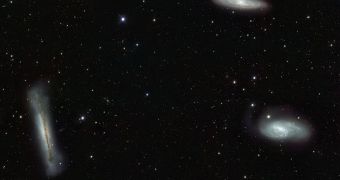Researchers working at the Paranal Observatory, in Chile, announce that they were recently able to grab a new image of a massive triplet of galaxies, which is located in the constellation Leo (the Lion).
The objects are a well-known group, and have been widely investigated by astronomers. The new image was taken using the Very Large Telescope's (VLT) Survey Telescope (VST), which is operated by the European Southern Observatory (ESO).
The VST OmegaCAM was instrumental for acquiring the tremendously precise images. What's more, experts figured out that they had been using the camera to only a small percentage of its true potential.
As you can notice in the attached image, the three galaxies are in perfect focus, but objects in the background can also be made out fairly well. With a little bit of tuning, it may be possible to use OmegaCAM to conduct mapping campaigns of the distant Universe.
The instrument is a massive, 268-megapixel camera, that is mounted on the 2.6-meter VST. The latter is the latest telescope that ESO installed at its Paranal facility, and is the largest in the world dedicated exclusively to surveying the skies in visible-light wavelengths.
Astronomers say that the Leo Triplet is a very beautiful structure, which is located about 35 million light-years away from Earth. The objects are heading towards each other, captures by intense gravitational forces that will most likely make them collide.
The process will begin in a few million years, and will most likely last several tens of millions of years after that. The merger of two galaxies is a long and complex process, but the merger of three takes even longer.
“All three of them are spirals like our own Milky Way galaxy, even though this may not be immediately obvious in this image because their discs are tilted at different angles to our line of sight,” an ESO press release reports.
“GC 3628, at the left of the frame, is seen edge-on, with thick dust lanes along the plane of the galaxy. The Messier objects M 65 (upper right) and M 66 (lower right), on the other hand, are inclined enough to make their spiral arms visible,” the document adds.
Due to the fact that the galaxies are really spaced apart, telescopes can usually study only one of these objects at any given time. The VST is capable of catching all of them because its field of view is almost two times broader than that of the full Moon on Earth's sky.
“In the foreground of the new image many point-like stars of varied brightness, lying in our own galaxy, can also be seen. One of the science goals of the VST is to search for much fainter objects in the Milky Way, such as brown dwarf stars, planets, neutron stars and black holes,” the release concludes.

 14 DAY TRIAL //
14 DAY TRIAL //